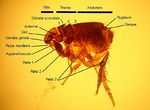Ctenocephalides felis
| This article has been peer reviewed but is awaiting expert review. If you would like to help with this, please see more information about expert reviewing. |
| Ctenocephalides felis | |
|---|---|
| Class | Insecta |
| Order | Siphonaptera |
| Family | Pulicidae |
| Species | Ctenocephalides felis |
Also known as: Cat flea
Ctenocephalides felis is the most commonly seen flea on both cats and dogs, and is of the order Siphonaptera. It is also an important intermediate host in the parasite Dipylidium caninum.
Hosts
Cats, dogs, and humans.
Identification
The adults are dark-brown, and have fascicles and laciniae adapted for piercing skin and sucking blood. They have large legs, containing resilin, adapted for jumping, and are laterally flattened, so they can easily move through the hair of the hosts. The adults have rows of spines, known as 'combs' or 'ctenidia', which are very important in the identification process. The first genal spine is 0.75 times the length of the second
Life Cycle
The female lays eggs directly on the host. These then fall off into the environment, and hatch into larvae. The eggs are strong and very resistant to environmental changes. The larvae undergo two further moults, before pupating within the cocoon (produced by the larvae.)
When the parasite is fully developed the adults emerge from the pupae, but remain within the cocoon. They will hatch out of the pupae when stimulated by movement, or heat. Overall, most of the life cycle is spent away from the host.
Test yourself with the Fleas Flashcards
Literature Search
Use these links to find recent scientific publications via CAB Abstracts (log in required unless accessing from a subscribing organisation).
Ctenocephalides felis publications since 2000

